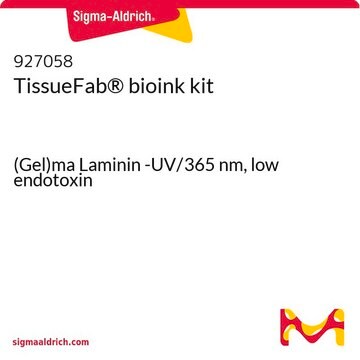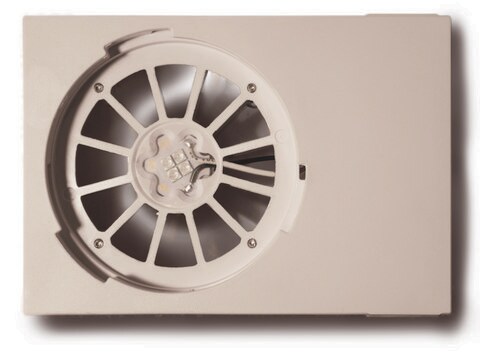추천 제품
형태
viscous liquid (gel)
Quality Level
불순물
<5 CFU/g Bioburden (Total Aerobic)
<5 CFU/g Bioburden (fungal)
<50 EU/mL Endotoxin
색상
pale yellow to colorless
pH
6.5-7.5
점도
10-40 cP(37 °C)
응용 분야
3D bioprinting
저장 온도
2-8°C
일반 설명
Gelatin methacryloyl (GelMA) is a polymerizable hydrogel material derived from natural extracellular matrix (ECM) components. Due to its low cost, abundance, and retention of natural cell-binding motifs, gelatin has become a highly sought material for tissue engineering applications.
Alginate is a naturally occurring polymer widely applied for bioprinting applications as its printability can be easily modified by altering the polymer density and crosslinking with the addition of calcium chloride (CaCl2). Alginate is often combined with gelatin to facilitate cell adhesion and differentiation.
Temporal and spatial control of the crosslinking reaction can be obtained by adjusting the degree of functionalization and polymerization conditions, allowing for the fabrication of hydrogels with unique patterns, 3D structures, and morphologies.
Alginate is a naturally occurring polymer widely applied for bioprinting applications as its printability can be easily modified by altering the polymer density and crosslinking with the addition of calcium chloride (CaCl2). Alginate is often combined with gelatin to facilitate cell adhesion and differentiation.
Temporal and spatial control of the crosslinking reaction can be obtained by adjusting the degree of functionalization and polymerization conditions, allowing for the fabrication of hydrogels with unique patterns, 3D structures, and morphologies.
애플리케이션
Gelatin methacrylate based bioinks have been used in the following bioprinting applications:
- osteogenic ,
- chondrogenic ,
- hepatic ,
- adipogenic ,
- vasculogenic ,
- epithelial ,
- endothelial ,
- cardiac valve ,
- skin ,
- tumors
TissueFab® bioink Alg(Gel)ma -UV/365 nm, low endotoxin is a ready-to-use bioink which is formulated for low endotoxin levels, high cell viability, and printability and is designed for extrusion-based 3D bioprinting and subsequent 365 nm light and calcium chloride crosslinking. This bioink can be used with most extrusion-based bioprinters, are biodegradable, and are compatible with human mesenchymal stem cells (hMSCs) and other diverse cell types. TissueFab® bioink Alg(Gel)ma -UV/365 nm, low endotoxin enables the precise fabrication of 3D cell models and tissue constructs for research in 3D cell biology, tissue engineering, in vitro tissue models, and regenerative medicine.
특징 및 장점
- Ready-to-use formulation optimized for high printing fidelity and cell viability, eliminating the lengthy bioink formulation development process
- Step-by-step protocols developed and tested by MilliporeSigma 3D Bioprinting Scientists, no prior 3D bioprinting experience needed
- Suitable for different extrusion-based 3D bioprinter model
- Methacrylamide functional group can also be used to control the hydrogel physical parameters such as pore size, degradation rate, and swell ratio.
법적 정보
TISSUEFAB is a registered trademark of Merck KGaA, Darmstadt, Germany
Storage Class Code
10 - Combustible liquids
WGK
WGK 3
Flash Point (°F)
Not applicable
Flash Point (°C)
Not applicable
가장 최신 버전 중 하나를 선택하세요:
Tyrosinase doped bioink for 3D bioprinting of living skin constructs.
Zhang H B, et al.
Biomedical Materials (Bristol, England) (2018)
Liliang Ouyang et al.
Biofabrication, 8(3), 035020-035020 (2016-09-17)
3D cell printing is an emerging technology for fabricating complex cell-laden constructs with precise and pre-designed geometry, structure and composition to overcome the limitations of 2D cell culture and conventional tissue engineering scaffold technology. This technology enables spatial manipulation of
B Duan et al.
Acta biomaterialia, 10(5), 1836-1846 (2013-12-18)
Tissue engineering has great potential to provide a functional de novo living valve replacement, capable of integration with host tissue and growth. Among various valve conduit fabrication techniques, three-dimensional (3-D) bioprinting enables deposition of cells and hydrogels into 3-D constructs
Wanjun Liu et al.
Biofabrication, 10(2), 024102-024102 (2017-11-28)
Bioinks with shear-thinning/rapid solidification properties and strong mechanics are usually needed for the bioprinting of three-dimensional (3D) cell-laden constructs. As such, it remains challenging to generate soft constructs from bioinks at low concentrations that are favorable for cellular activities. Herein
Janet R Xavier et al.
ACS nano, 9(3), 3109-3118 (2015-02-13)
Despite bone's impressive ability to heal after traumatic injuries and fractures, a significant need still exists for developing strategies to promote healing of nonunion defects. To address this issue, we developed collagen-based hydrogels containing two-dimensional nanosilicates. Nanosilicates are ultrathin nanomaterials
자사의 과학자팀은 생명 과학, 재료 과학, 화학 합성, 크로마토그래피, 분석 및 기타 많은 영역을 포함한 모든 과학 분야에 경험이 있습니다..
고객지원팀으로 연락바랍니다.








